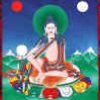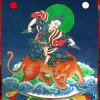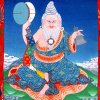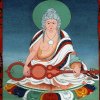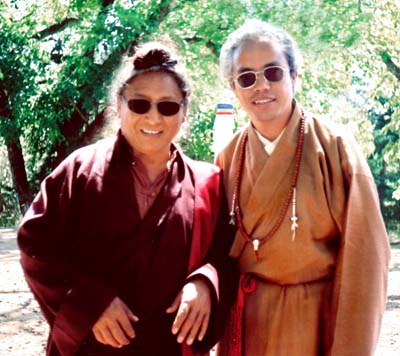
Kumar Lama
Biography
The thangka is an expression of the inner world of Tibetan Buddhism and a powerful way of
accessing the Tantric view of reality.
– Kumar Lama
Venerable Kumar Lama is a master thangka painter whose artistry has been praised by many Nyingma Lamas. He is currently the resident artist and thangka painting teacher at Pema ’ö-Sel Ling – the retreat centre established by Tharchin Rinpoche – in the Santa Cruz Mountains in California. Kumar Lama is a deeply dedicated teacher and yogi whose driving intention is to preserve the traditions and purity of thangka painting – and to bring this knowledge to the West.
He was born in Yolmo, an area of indigenous Vajrayana Buddhist culture in Nepal – near the borders of Tibet. He was discovered as a prodigy by the highly revered Palden Lama, and began his training at the age of nine. His thangka painting teacher died when he reached the age of fifteen – at which point Kumar Lama walked for five days through mountains and jungle to find the famous thangka painter Jig’mèd Lama. He was accepted as a student by Jig’mèd Lama and completed his training by developing his extant skills to peak of perfection, which has since been recognized and sought after by many important Lamas. This led to painting wall murals in several Gompas in Kathmandu. In 1988 he was discovered by Chögyal Namkha’i Norbu Rinpoche – which led to invitations to Italy, Switzerland, Germany, Austria, and France. In 1994 he met Tharchin Rinpoche who invited him to come to reside at Pema ’ö-Sel Ling as the master artist under the sponsorship of the Vajrayana Foundation. In 1999 he completed work on a large thangka (measuring 5½ feet by 8 feet) of the Düd’jom gTér lineage tree – which can be seen by appointment if one visits Pema ’ö-Sel Ling. It is a breathtaking accomplishment and provides a dramatic vision of the non-dual grandeur of Vajrayana. The intricate details of the painting were personally supervised by Tharchin Rinpoche and as such it represents a completely authentic demonstration of the realised legacy of the Düd’jom gTér.
In 1995 Kumar Lama met Ngak’chang Rinpoche and Khandro Déchen in Nepal. They have come to know of him for his intricate knowledge of Vajrayana symbolism and his capacity to bring visionary images to life. Kumar Lama is a personal friend of Ngak’chang Rinpoche and Khandro Déchen, and Kumar Lama has accepted the challenge of painting a series of thangkas for the Confederate Sanghas of Aro, depicting all the lineage Lamas of the Aro gTér: Yeshé Tsogyel, Ma-gÇig Labdrön, Jomo Menmo,Jomo Chhi’èd Pema, Jomo Pema ’ö-Zé, Rang-rig Togden, Khyungchen Aro Lingma, Aro Yeshé, A-yé Khandro, A-shé Khandro, Akyong Düd’dül Dorje, Gomchenma Künzang Rang-rig Longtsal, and the five Dakini Mothers of Aro Yeshé – Khandro Ja’gyür ’ö-Zér Nyima; Khandro Chö-ying Nyima ’ö-Zér; Khandro Rig’dzin Gong-tsal Takmo; Khandro Tsé-wang Gyür’mèd Pema; and Khandro Shardröl Rinchen Wangmo.
Ngak’chang Rinpoche says of Kumar Lama:
Kumar Lama is
magnificent—both as a person and as a visionary artist. His magnificence lies in his
precision and consummate fluid ease. His paintings are luminous and clear in their sumptuous
simplicity. His sense of harmony and visual balance are both natural and the result of utter
dedication to the minutiæ, in terms of symbolic significance. Often where other lesser
painters might flounder in terms of the unusual qualities of gTérma images, Kumar Lama is
both inspiringly confident and relaxed. He truly lives in the sphere in which he portrays these
fabulous realities, and it is an honour to be his friend.
Khandro Déchen comments:
The Aro gTér lineage Lamas Kumar Lama has
painted have brought our lineage alive for students in a remarkable way – and in a way
which we believe would have proved insurmountably difficult for many other thangka painters.
There are few easily available images within the iconography of Vajrayana which portray powerful
middle aged women – and the Aro gTér is made up almost entirely of such women.
Lamas are usually painted as being the age they were when they had accomplished something
important – so Aro Lingma is shown as a young woman and Aro Yeshé is shown as a boy
of eight years. A-yé Khandro and A-shé Khandro are shown as teenage girls and the
five mothers are shown from varying ages from 23 to 64. Kumar Lama’s skill and elaborate
knowledge of Vajrayana visionary appearances enables him to execute work of the most inspiring
kind and give a depth and breadth of the history of the Aro gTér which would otherwise
not have been possible.
